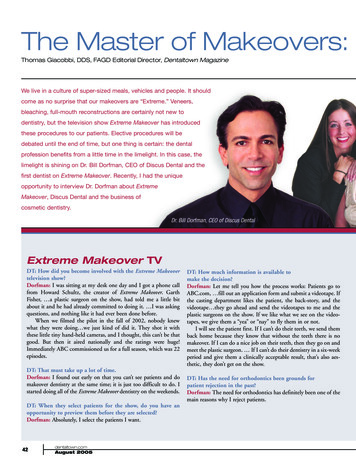
Transcription
The Master of Makeovers:Thomas Giacobbi, DDS, FAGD Editorial Director, Dentaltown MagazineWe live in a culture of super-sized meals, vehicles and people. It shouldcome as no surprise that our makeovers are “Extreme.” Veneers,bleaching, full-mouth reconstructions are certainly not new todentistry, but the television show Extreme Makeover has introducedthese procedures to our patients. Elective procedures will bedebated until the end of time, but one thing is certain: the dentalprofession benefits from a little time in the limelight. In this case, thelimelight is shining on Dr. Bill Dorfman, CEO of Discus Dental and thefirst dentist on Extreme Makeover. Recently, I had the uniqueopportunity to interview Dr. Dorfman about ExtremeMakeover, Discus Dental and the business ofcosmetic dentistry.Dr. Bill Dorfman, CEO of Discus DentalExtreme Makeover TVDT: How did you become involved with the Extreme Makeovertelevision show?Dorfman: I was sitting at my desk one day and I got a phone callfrom Howard Schultz, the creator of Extreme Makeover. GarthFisher, a plastic surgeon on the show, had told me a little bitabout it and he had already committed to doing it. I was askingquestions, and nothing like it had ever been done before.When we filmed the pilot in the fall of 2002, nobody knewwhat they were doing we just kind of did it. They shot it withthese little tiny hand-held cameras, and I thought, this can’t be thatgood. But then it aired nationally and the ratings were huge!Immediately ABC commissioned us for a full season, which was 22episodes.DT: That must take up a lot of time.Dorfman: I found out early on that you can’t see patients and domakeover dentistry at the same time; it is just too difficult to do. Istarted doing all of the Extreme Makeover dentistry on the weekends.DT: When they select patients for the show, do you have anopportunity to preview them before they are selected?Dorfman: Absolutely, I select the patients I want.42dentaltown.comAugust 2005DT: How much information is available tomake the decision?Dorfman: Let me tell you how the process works: Patients go toABC.com, fill out an application form and submit a videotape. Ifthe casting department likes the patient, the back-story, and thevideotape they go ahead and send the videotapes to me and theplastic surgeons on the show. If we like what we see on the videotapes, we give them a “yea” or “nay” to fly them in or not.I will see the patient first. If I can’t do their teeth, we send themback home because they know that without the teeth there is nomakeover. If I can do a nice job on their teeth, then they go on andmeet the plastic surgeon. If I can’t do their dentistry in a six-weekperiod and give them a clinically acceptable result, that’s also aesthetic, they don’t get on the show.DT: Has the need for orthodontics been grounds forpatient rejection in the past?Dorfman: The need for orthodontics has definitely been one of themain reasons why I reject patients.
William Dorfman,DDS, FAACD“When people startedgoing to the supermarketand buying whiteningproducts, that had a realnegative impact ondentistry. Then alongcomes a product likeZoom, now patients arecoming back to thedentists because nothing in thesupermarket can getyour teeth eight shadeswhiter in an hour––nothing.”Dr. Bill Dorfman,CEO of Discus DentalDiscus DentalDT: Once their makeover is complete, do patients have toagree with you on some level that they will follow-up with adentist at home? How does that transfer happen from finishing the makeover and returning to their dentist at home?Dorfman: First of all, we don’t just do their teeth. Whenthey come in we do a full set of x-rays, an exam, a cleaning;we do everything. Once we get them done and [the patients]are in perfect dental shape, we send them home. A lot of themhave their own dentist and they just go back to their own doctor.If they don’t, I’ll find a dentist for them in their area.DT: How does the schedule usually go? Once the patientcomes to California, do you see them at the beginning of theirvisit to perform the dental part of the makeover?Dorfman: We only have them here for six weeks––so I don’t havea lot of time. Frequently, I am doing a full-mouth reconstructionin two weeks. The only time I get to see the patient first, is if thepatient needs extractions or perio.DT: At Discus Dental, one of your main products is the ZoomII Bleaching light. Is there room for improvement in thisprocess––would you choose to get the bleaching done faster orcan the teeth get any whiter?Dorfman: I think it is hard to separate the two. If you made me pickwith a gun pointed to my head, I would say, do what you have to do toget the best results. Results are the thing that walks out the door; resultsare what bring more patients in; results are what people are paying for.DT: Do you think the flood of OTC bleaching products hasaffected the fee that can be charged for in-office bleaching?Dorfman: Absolutely––here is what happened with the evolution ofbleaching products. It wasn’t until the late ‘80s that take-home toothwhitening came into vogue with trays that we started to see a real difference with tooth whitening. When people started going to the supermarket and buying whitening products, that had a real negative impacton dentistry. Then along comes a product like Zoom, now patients arecoming back to the dentists because nothing in the supermarket canget your teeth eight shades whiter in an hour––nothing.Continued on page 44dentaltown.comAugust 200543
Continued from page 43DT: With the popularity of Extreme Makeover and the associatedbranding of Zoom bleaching, will Discus Dental consider selling OTC bleaching products?Dorfman: We are really committed to dentists and we feel verystrongly that the safest, fastest, most effective way to whiten yourteeth is still in a dental office. We are not even looking at any plansto go OTC right now.DT: Discus Dental has a much diversified portfolio of productsincluding burs, impression materials, breath treatments, software and bleaching. Will you consider other product lines? Forexample, endodontics or orthodontics.Dorfman: We are always adding new products. There are some thingscoming out in the near future that will go into some of these otherfields that you mentioned, but I can’t really mention them. We aredefinitely trying to branch out and diversify as much as we can.DT: Discus Dental has a reputation for terrific marketing. Wasthat a high priority when you started the company?Dorfman: My whole concept with Discus when we first started thecompany was this : there are a lot of whitening products out there,but none of them were great. The packaging wasn’t great, it wasn’tuser-friendly, the product could have been flavored , it wasn’t easyto use and it was a big market. But you know, in those days selling the product for 800 to the patient, I was embarrassed withwhat the patient was walking out with. Even the directions for usewere really shoddy. I tried to approach it with all the big companiesin dentistry and say “look guys, let’s build a bettermousetrap” they were all just kind of shoving me away. At thesame time, I met my business partner, Robert Hayman. Robertgrew up in the cosmetic industry and he knew how to market andpackage cosmetics. If we can take his marketing and packaging andmy ideas for dentistry and combine them together, we could have awinning team. That is exactly what we did. We were the firstproduct to be flavored. I wanted the product to look like a cosmeticand not like a medical procedure. I wanted it to have easy directionsfor use. I wanted it to supply all of the ancillary marketing materials for counter cards, statement stuffers, and brochures. Everythingthat you need to make this product move on the shelf; so when youask me was it my goal to make our product and our advertising thebest in dentistry absolutely.When we shot our first model shot, I looked in a magazine andsaw a beautiful ad from Benetton; with five beautiful models, clean, fresh, young, multi-ethnic. I said you know what, that’swhat we need in dentistry. So, we shot our first model shot that wayand we made quite a controversy in the dental industry. Nobody hadever marketed dental products like that before. I’ll never forget oneof the early things that Robert said. I said to him, “Robert, thesemodels are all so young, they are in their early 20s and our demographics, our market is much older, the 50s.” I said, “don’t you thinkwe should use some models who are older.” He said, “Bill, middleaged women don’t purchase cosmetics from middle-aged women.They buy it from young beautiful supermodels.” And he is right.Cosmetic DentistryDT: What do you think is the most important skill for anaccomplished cosmetic dentist?Dorfman: I think the most important skill is communication. It iskind of like the sizzle on the steak. I mean you have to have a lot ofsizzle to get the patients to the restaurant, but if the steak doesn’ttaste great, they don’t send their friends. I think it is truly two thingsthat you have to have to be a great dentist. First, you have to havegreat communication skills; you have to be able to talk to yourpatients, understand what it is they want you to do and you need tomake them feel comfortable. Second, you need to do it. I think ifyou can combine the communication skills with great clinical excellence, you’ve got a winning team right there.That’s why it is so critical that dentists continue to takecontinuing education courses. If you don’t feel that your skills areup to par with cosmetic dentists in your area you’ve got to takehands-on courses. You’ve got to go to LVI, you’ve got to go to thePankey Institute, take Ross Nash’s course or Larry Rosenthal’shands-on courses or any of the great courses where they can bringyou up to speed and teach you how to deliver the steaks.DT: Aside from Discus products, what are three instruments ormaterials that you can’t live without?Dorfman: The three things that I couldn’t live without is numberone, Expa-syl by Kerr––that replaces retraction cord in 99% of allthe work I do. I absolutely wouldn’t want to practice dentistry without that. Number two, I would say is probably the Wand, especiallyfor TV dentistry. You need to be able to make your patients comfortable and have the ability to smile and articulate afterward without appearing numb and then I would probably say a laser:Biolase, electrosurge, whatever you need to cosmetically alter tissueto create a smile with the symmetry that it needs.DT: Who are your idols in business?Dorfman: Number one – Robert Hayman, my partner. Theguy is brilliant. One of the luckiest, and now in hindsight,one of the smartest decisions I ever made in my life, was bringinghim into dentistry. He is unbelievably gifted; he has anincredible knack for comprehension above and beyond anything Ihave ever seen. My grandfather, Arthur, was a huge mentor in my life. Hewas one of the most dynamic and articulate speakers of all time.He was a real trendsetter for modern-day marketing. Just his techniques for motivating his sales reps and getting people to buy aproduct were revolutionary. I wish my grandfather would have written a book. He was out there teaching his reps not to take orders,but to make sales. That was something new in the ‘40s and ‘50sbecause people were used to writing orders. That is one of the thingswe did that was really unique in dentistry too; we didn’t just hireorder takers; we hired sales reps that were able to educate the doctors and help them understand the need for buying other productsas well as the one that they were calling to order.Continued on page 4644dentaltown.comAugust 2005
Continued from page 44Makeover Dentistry AsAn IndustryDT: Do you think cosmetic dentistry should be some type of adegreed specialty, and if so, what would the requirements be?Dorfman: I would like to have cosmetic dentistry be a recognizedboard specialty; our profession is so antiquated in the way it progressesthrough these things that I don’t see that happening. For the time being,let’s just try and be content with getting accredited or a fellowship inthe American Academy of Cosmetic Dentistry and going through thePankey Institute and that is the best thing to do at this point.DT: When a dentist, with the best of intentions, performs a badmakeover; where do you find they go wrong most often?Dorfman: I think that most often the dentists don’t listen to whattheir patients want, and that is where they go wrong. When people are going to you and paying you a lot of money to have somethingdone, especially something that is elective, if you don’t listen, you aregoing to end up blowing it. . One of the things that I find reallymakes doing cosmetic dentistry predictable is doing a great, accuratemock-up and making sure that the patient leaves with temporariesthat approximate as closely as possible what the permanent ones willlook like. Because if you can’t make temporaries look the way theywant, how can the lab know how to make the permanent one look?DT: Let’s say someone comes in your office and wants 10 veneerson top, what is the sequence, starting with the consultation?Dorfman: Right, the first would be a consultation. A lot of times inorder to do 10 veneers we are going to have to Zoom the lowers andget them as white as we can. Next, they’ll come in and we’ll do a prepappointment and a seat appointment. The prep appointment will dothe mock-up and we’ll use this technique I developed we call theprep-guide, which helps the laboratory match what my mock-uplooks like to know what the teeth are going to look like. Typically,that would be a 2.5-hour prep appointment. I’ll do the mock-up,prep half the teeth and then I leave and I’ll have my associate prep theother half. The patient will leave with custom temps. A week laterthey’ll have a two-hour seat appointment and I’ll numb the patientand try in everything, seat everything, that will take an hour, then I’llhave my assistant come in and clean off the excess resin and all that.DT: Do you have an appointment before they prep and after the consultation where you review the mock-up, or the wax-up, with the patient?Dorfman: The only time I do that is on cases where I feel I need todo that to get the case exactly the way they want it. If I have apatient who is really picky and has aesthetic concerns that I thinkwarrant that; then I’ll have the patient come in one time before weactually do the seat appointment to review their veneers and theirtemporaries. A lot of times I will have the case brought back earlyfrom the lab so we can look at the case together.Continued on page 48FREE FACTS, circle 19 on card46dentaltown.comAugust 2005
Continued from page 46DT: How do you respond to a patient who asks you how longwill my veneers last?Dorfman: The average dental restoration lasts 10 years and the reason it fails is due to decay nine times out of 10. If you take goodcare of these veneers and you brush and you floss, see us regularly,they could last your whole life. It depends if they take care of them,if the patient is a bruxer and they need to wear a nightguard, thereare a lot of different criteria. I have patients with veneers for 20years and they look as good as they did 20 years ago. I have otherpatients [who received veneers] less than 10 years ago and we’veredone them, not because they are failing, but because teeth weren’tas white 10 years ago as they are today. The main reason I amredoing cases today is because people want their teeth whiter, notbecause the veneers aren’t holding up.DT: In your private practice, do you do procedures other thancosmetic dentistry?Dorfman: We do everything; I just do the cosmetic stuff. I have sevendentists working in my office now; between all of us everything gets done.DT: What clinical trends do you see for the future of cosmeticdentistry? Will there be a major shift in techniques?Dorfman: I think that dentistry is becoming more conservative andthat we are trying to preserve more of the tooth structure. You seeall these ultra-thin veneers and things like that, and I bet before toolong we’ll be replacing enamel with enamel, or enamel substitutes––I am sure that is on the horizon.DT: Does the popularity of elective procedures such ascosmetic dentistry eventually result in a reduction of fees?Dorfman: When we see a reduction in fees it’s for a mass production. When we started making Nite White kits, the cost per kit wasa lot more than it is now because we do millions of units. You can’tlook at cosmetic dentistry like that. It’s not being mass produced,it’s still an individual thing, so I don’t think that is going to drivethe price down. The fact that there are more dentists doing it and itis more competitive, yeah possibly. I think if you are good, create aniche in your area and people get to know you for what you do; andyou can, like I said, deliver the steak with the sizzle, you candemand the price that is fair for your area. You don’t have to compete on price, you can compete on quality.DT: The AACD recently released the results of a survey on thestate of cosmetic dentistry. One of the key results indicated thatthe prime patient concerns are cost, appearance, and longevity.You and I have already talked about cost and longevity. Regarding appearance, do you find that that’s true for yourpatients?Dorfman: I have patients where that is the number oneconcern––they may not care or ask about cost or longevity, they justassume [the case] will have longevity, but their only concern is,“what am I going to look like?”DT: So in ranking those three things in order of preference,would you say that most patients would put appearance first?Dorfman: My practice is really in a different type of area and mypractice doesn’t necessarily mirror what you will see across America.In Beverly Hills, I would say it is appearance, then longevity andcost. People don’t come to me to save money. They almost expect topay more. But I would say that is the exception rather than therule. A lot of places cost is [the number one] thing. Many of thecases I redo for patients, the first thing they say is: “I shouldn’t havegone to that cheap guy. I would have come to you but I thought youwould be a lot more expensive and now I don’t care what it costs,just make them right.”DT: I just want to ask you if there is anything you would like tosay on cosmetic dentistry, Extreme Makeover or dentistry today?Dorfman: In closing, I would say that the time to practice dentistrynow is better than it has ever been. Dentists should be aware of howfortunate we are to be in such an amazing profession. It’s not justabout changing their smiles, but changing their whole life and theirwell being. Being able to do that on a daily basis in a profession thatis as highly regarded as ours, is a real honor and a privilege.Prevention of disease is the foundation of our profession. If weimmunize children to eliminate decay, will we wither on thevine? Certainly not. In fact, the focus on makeover dentistryand elective procedures is a signal that our profession is evolving, and progress is good. Dr. Dorfman, thank you for yourcontinuing contributions to our evolution.“The averagedental restorationlasts 10 years and the reasonit fails is due to decay ninetimes out of 10”Dr. Bill Dorfman,CEO of Discus Dental48dentaltown.comAugust 2005
debated until the end of time, but one thing is certain: the dental profession benefits from a little time in the limelight. In this case, the limelight is shining on Dr. Bill Dorfman, CEO of Discus Dental and the first dentist on Extreme Makeover. Recently, I had the unique opportunity to interview Dr. Dorfman about Extreme










